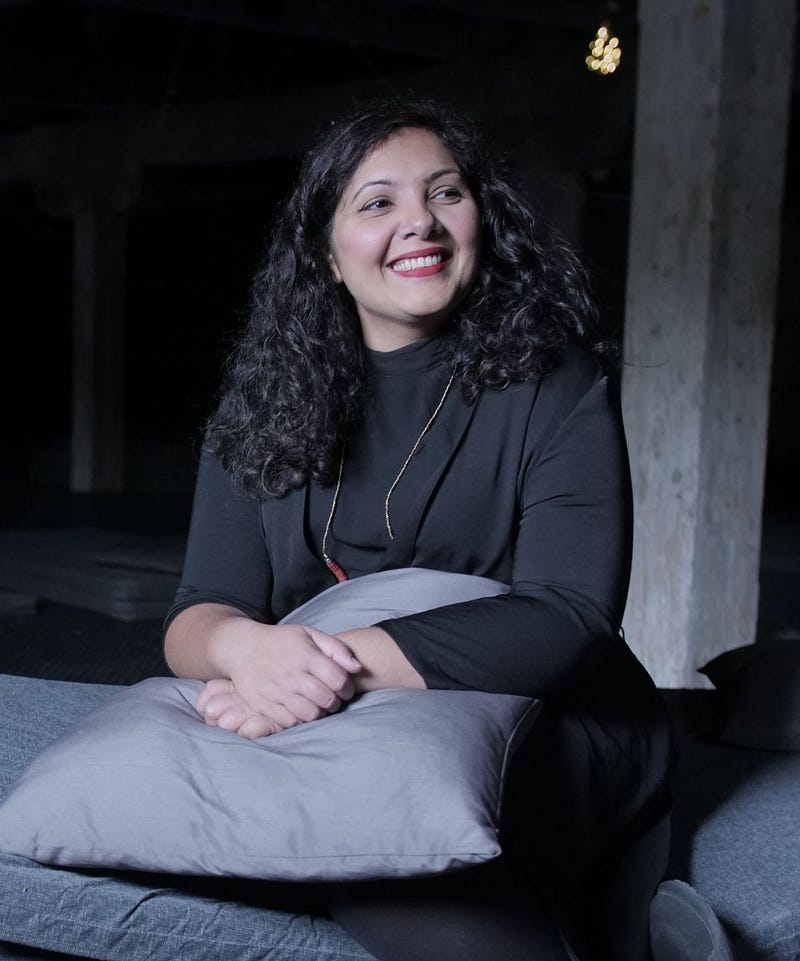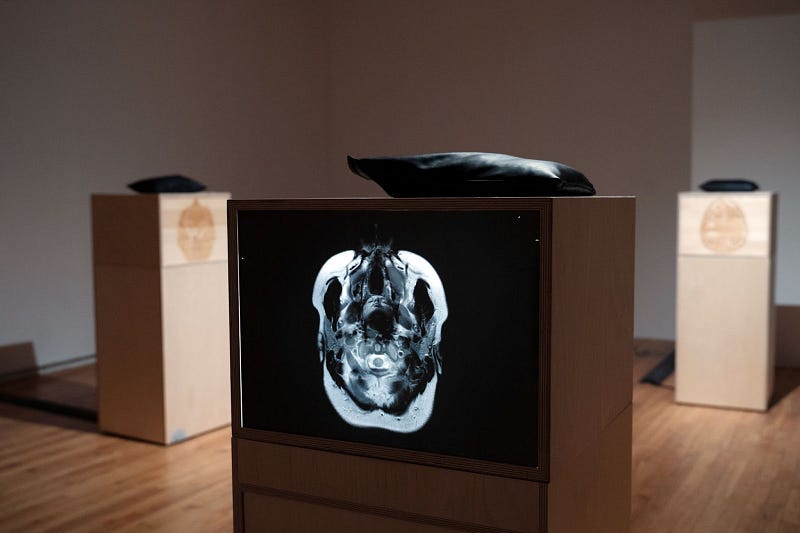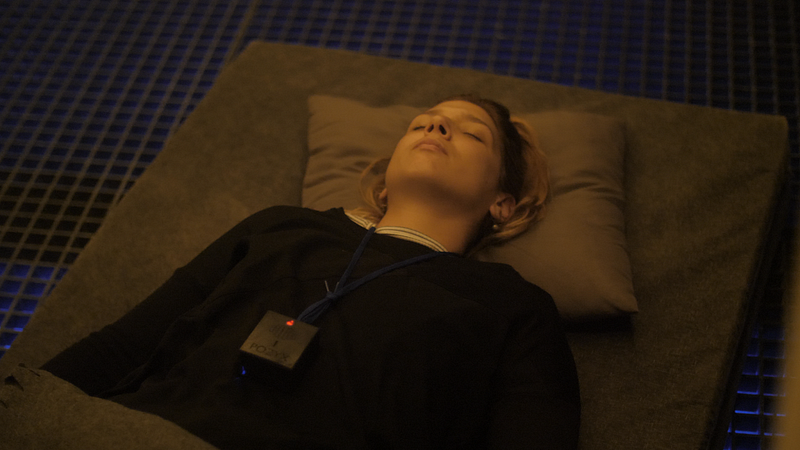Embodiment as an Entry Point — At the Intersections of Art, Tech & Care
An interview with multisensory artist Salima Punjani on fostering intimate connection in immersive art installations
 Portrait of the artist by Bence
Mladin at the Spatial Sound Institute, Budapest 2020, courtesy of Salima
Punjani
Portrait of the artist by Bence
Mladin at the Spatial Sound Institute, Budapest 2020, courtesy of Salima
PunjaniSalima Punjani is a Montreal artist working in installations and facilitating participatory environments, connecting audiences with access through multiple senses and a diverse set of media. Her art centers welcoming and counters alienation. Initially working in journalism to highlight under-documented communities, her recent pieces are multi-sensory, including soft sculptural installations as sources of sound, vibration and scent, as well as works that incorporate biometric data like recorded heartbeats and brainwaves. One that has particularly foregrounded co-authoring with disabled people is Progression, created in 2018.
Progression features MRI brain scans of several people with multiple sclerosis (MS), including Salima. Each participant contributed an MRI image and a photo portrait they wanted Salima to layer together to offer a narrative around cognitive change that might challenge assumptions.
Besides the photographic composites, she laser-engraved wood panels to reproduce fine detail from each subject’s brain scan, providing tactile, non-visual access to the pattern images. She also recorded and sonified each participant’s brainwaves while they were interviewed about their portraits. Then, she created small stuffed pillows containing vibrotactile transducers to send each subject’s distinct wave patterns through in tactile pulses, so exhibit attendees could feel them while touching the pillows, as a non-hearing mode of access. Wanting to familiarize attendees with these technologies in a non-intimidating way, Salima’s been present to offer introductions for trying on Muse headsets available in the installations, to directly experience the EEG headsets’ brainwave-sensing transmission to a vibration pattern format.
The most recent public activities she’s shared have been tactile/listening events with groups of youth or adults, facilitated online or in person outdoors. Attendees are introduced to vibrotactile pillows, which vibrate according to sound samples that each participant contributes. In the events, people then take turns experiencing and commenting on the sonic and haptic patterns they perceive.
Since meeting Salima soon after I moved to Montreal in 2017, I’ve been struck by her care in fostering artful narratives that focus on connecting with both the subjects featured in her projects and the audience, providing multiple entry points to enable inclusion and agency for people with a range of embodiments. I’m excited to share this interview conversation, edited for clarity. Find more on her work at: https://cargocollective.com/salima
 MRI/portrait image and pillow
sample from Progression (2021), Ada X artist-run centre in Montreal. Photo by Vjosana
Shkurti
MRI/portrait image and pillow
sample from Progression (2021), Ada X artist-run centre in Montreal. Photo by Vjosana
Shkurtiseeley quest: Can you talk about your focus of inviting reflections on community experiences, and on choosing to explore different technologies for entry modes?
Salima Punjani: Community experiences are important to me. I don’t feel there needs to be a dichotomy between community or socially engaged art and what’s considered professional art. Working in community with technology, like [hosting] sensory listening workshops, is quite meaningful for me … [such public activities are] some of my favorite things that I do. People are invited to bring a sound based on a theme: comfort or belonging or whatever feels relevant at the time, and we come together. So far I’ve held the workshops at a city park, and with [the artists’ centre] Ada X in person as well as online.
It creates an opportunity to deeply listen to each other, not just through words but through felt sensation and a way to have an immersive experience even if maybe we don’t have so much capacity. It helps people have a certain quality of presence with each other, and people give really meaningful feedback and interpretations to each other. And it’s simple — it’s just a sound and a vibration and the energy of us together. Moving forward in my work I’m heading towards a bit more simplicity; when it comes to technologies I’m trying to simplify things because constantly figuring out new technology [isn’t that accessible for me].
sq: You’ve been working on projects involving translation: renderings of relationships to neurological change by people with MS, transmission of sound to pulse patterns that can be felt by Deaf audiences. How do you approach the concept of translation?
SP: When you’re feeling brain waves, you’re feeling the frequencies that I’ve chosen for you to feel, translat[ing] biodata in a way that isn’t to find something wrong, but instead builds connectedness between people.
sq: How are subjects responding to the presentation of their content? Are audiences responding in any ways you wouldn’t anticipate?
SP: I’m shocked [subjects are] so chill about using their biodata. I made Progression in 2018 and have exhibit[ed] it five times after that, even though people’s stories have changed. We joke about that; they actually are saying I should do an updated version with stories that are more recent. People are happy to share their stories and to dimensionalize the experiences of people with MS past the assumptions that exist.
Another piece, The Cost of Entry as a Heartbeat (2020) uses heartbeat data and sounds recorded in Budapest thermal baths to create a collective rest environment. For most people it’s very relaxing, yet for others the opposite; I’ve had some big reactions to the piece. Both of the times [it’s been installed], there’ve been people that had panic attacks or strong stress responses, because the heartbeat [sound] was too fast, or they hadn’t really had experience with such an immersive environment.
I’m grateful I have training in care work so I know what to do when that happens. It’s the reason I studied social work, to slow down and really think about how to make sure there are structures of care in my projects. There are often ways people react that aren’t what I anticipated in creating a project, and at the same time I feel relatively confident that I have skills to support if something comes up. [I take] the evocative potential of art seriously, not lightly at all.
 Image captured from The Cost
of Entry is a Heartbeat (2020), courtesy of the artist
Image captured from The Cost
of Entry is a Heartbeat (2020), courtesy of the artistq: Do you have goals regarding immersive encounters?
SP: Yes. I’ve had the opportunity to experience spatial sound in magnificent contexts: at Monom in Berlin, the Spatial Sound Institute in Budapest, and Lobe studio in Vancouver. My interests lie in bringing experiences to communities: disabled folks, BIPOC folks, people at intersections that might not have access to go into these sound studios, as there are only three in the world that use 4D sound technology. I’m currently, through support of the Canada Council of the Arts, working on developing a mobile spatial sound studio to bring into schools or different communities, to democratize the technology a bit. It’s in a space where people have to go to it now, but I’d like to bring it to people. It’s valuable to offer these immersive experiences of rest to communities underserved. So that’s big for me, to democratize vibrational multi-sensory environments.
This summer a collaborator, Greer Pester, and I worked on developing large vibrotactile soft sculptures based on body parts and we finished the project with making a ’zine: a version of an experience which can be mailed to people that has prompts and different materials that explore the senses. I’ve experienced powerful work, such as Ray Young’s THIRST TRAP (2022) through London’s Unlimited Festival that I had the opportunity to go to this year. THIRST TRAP was an at-home experience where you listened to an audio file, and received this box that had different materials. It was meant to be experienced in the bathtub and was about climate change …put together in a way that felt like a ritual — immersive through smell, light, water temperature and the depth of the water being so specific — and a bath bomb. Incredibly well done, it had great entry and exit rituals, made you feel part of something collectively [and was available for] a good length of time so you could access it whenever you had the capacity to spend that time to experience it.
I’m excited to see how these kinds of care or exhibition packages can support people in experiencing immersive work. I’m working on developing a project related to grief and collective care that will find a way to do this. [I’m] moving towards some simplicity, also play and pleasure in my work.
sq: Would you expand on your next directions?
SP: I’m working on this mobile spatial sound studio, with a grant from the Arts Council for two more years to dig into my research areas. I’m [building] a performance piece/ritual that invites letting go of something, holding something for someone else, and having some sort of collective release related to grief and loss to create a space where holding something for someone else feels possible without it feeling overwhelming. My activism is based on mutual care and mutual aid in a loving way, dealing with things collectively present and hard to hold, and finding ways to bring that into an artistic space that can give a tiny bit of relief.
I’ll host a gathering space for disabled artists at Trinity Square Video in Toronto, July 2023. Aimee Louw’s poem about being held in an unspectacular space was really inspiring to me. I’d like to host an informal gathering for artists to come together and just be with each other, without some event or conference.
In 2024 I’m heading towards curation at Tangled Gallery. I’ve been invited to create a show so I’m researching artists, just meeting people, visiting studios, talking to curators I admire, bringing learnings I’ve had from the disability arts community over the last few years to my curatorial practice.
This piece is part of Immerse’s 2023 issue centering disability innovation in documentary and emerging tech — presenting perspectives from artists, activists, scholars and technologists at the vanguard of storytelling and disability justice. You can find other featured stories and more information about the issue here.
For more news, discourse, and resources on immersive and emerging forms of nonfiction media, sign up for our monthly newsletter.
Immerse is an initiative of the MIT Open DocLab and Dot Connector Studio, and receives funding from Just Films | Ford Foundation, the MacArthur Foundation, and the National Endowment for the Arts. The Gotham Film & Media Institute is our fiscal sponsor. Learn more here. We are committed to exploring and showcasing emerging nonfiction projects that push the boundaries of media and tackle issues of social justice — and rely on friends like you to sustain ourselves and grow. Join us by making a gift today.